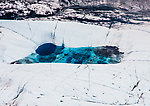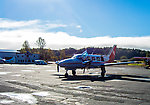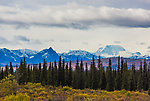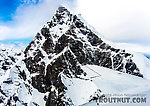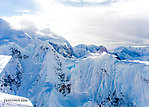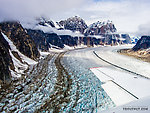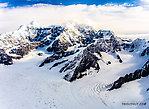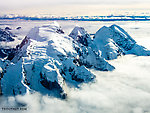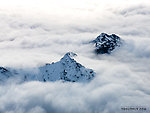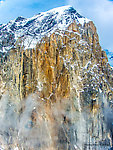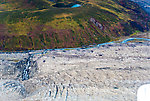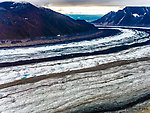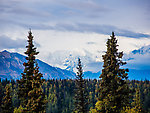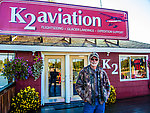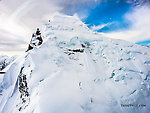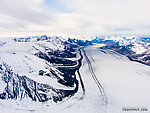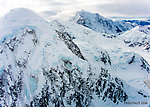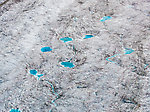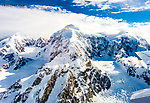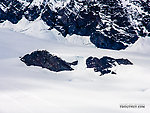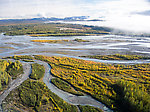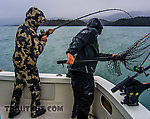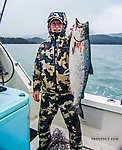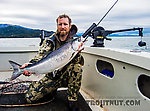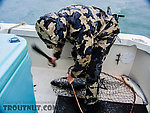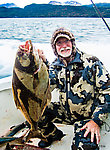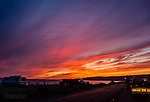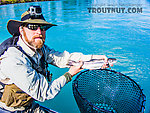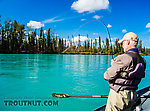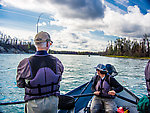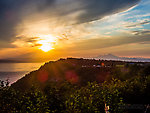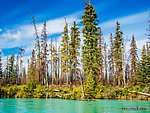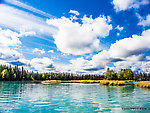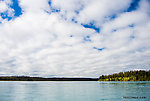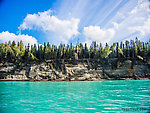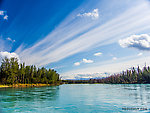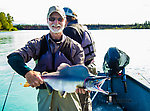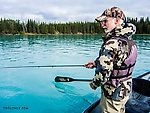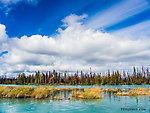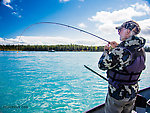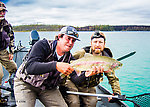Blog & Latest Updates
Fly Fishing Articles
Insects by Common Name


Latest updates, page 31
Flight-Seeing Tour from Talkeetna to Denali
This was the final day of a five-day, father-son fishing trip to south-central Alaska. Jason and I awakened to sunny skies at the Swiss Alaska Inn in Talkeetna. While enjoying breakfast in their fine restaurant, we checked out some Denali flight tour brochures. McKinley Tours with K2 Aviation had one route called the “Grand Tour” that would provide high-altitude views in relatively clear skies without ascending all the way to the summit, which was still shrouded in clouds. Luckily, they had room for a couple “walk-on” passengers for the tour that departed at 10:30 a.m., so we booked it. I elected not to inform my wife, Sandy, of our plans before the flight, judging that she had enough to worry about at home after a September 4 windstorm in NW Wisconsin had dropped a couple large trees on our attached garage roof.
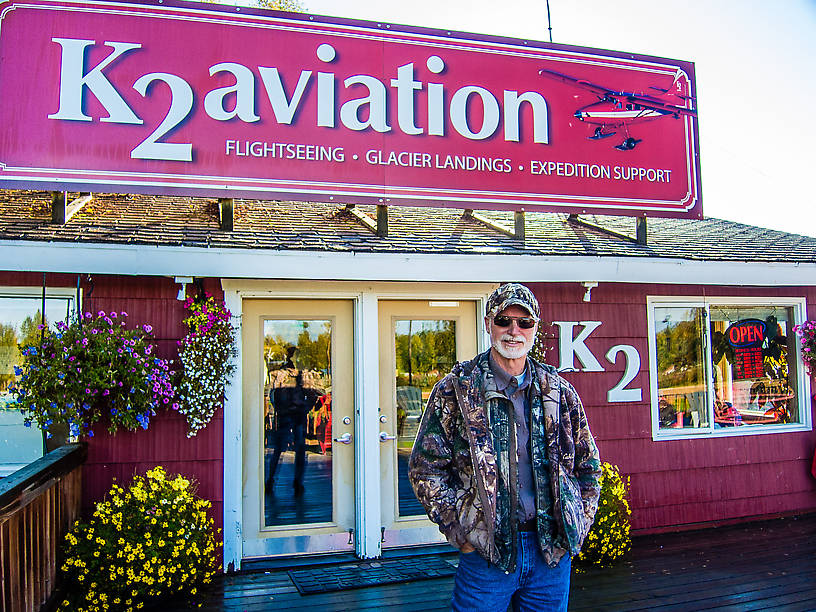
Our pilot and guide, Rick, was professional, knowledgeable, and had a good sense of humor, so he inspired confidence and provided entertaining narrative the entire 1.5-hour flight. Jason and I sat in the rear-most seats of the twin-engine, ten-seat plane, enjoying more legroom and greater lateral (Lateral: To the side.) vision than the other five passengers because we were far behind the wings.
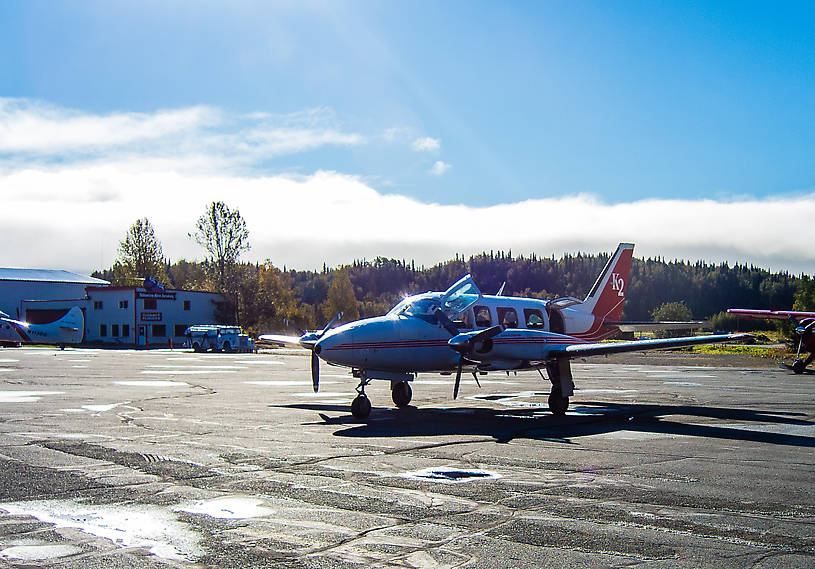
Shortly after take-off, we flew over the highly braided channels of the converging Talkeetna, Chulitna, and Susitna rivers.
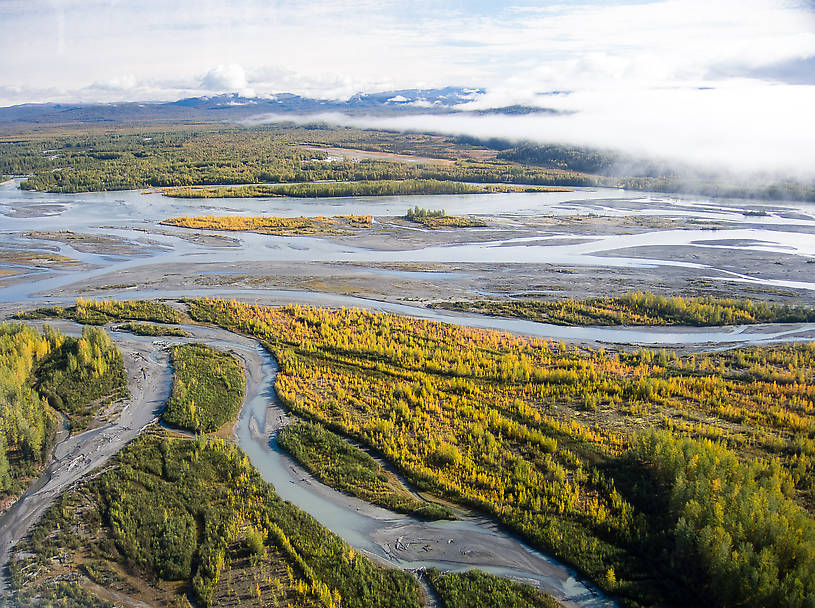
Within 15 minutes were entering the foothills of the Alaska Range. And before long we were viewing glaciers, sheer rock faces, and craggy peaks.

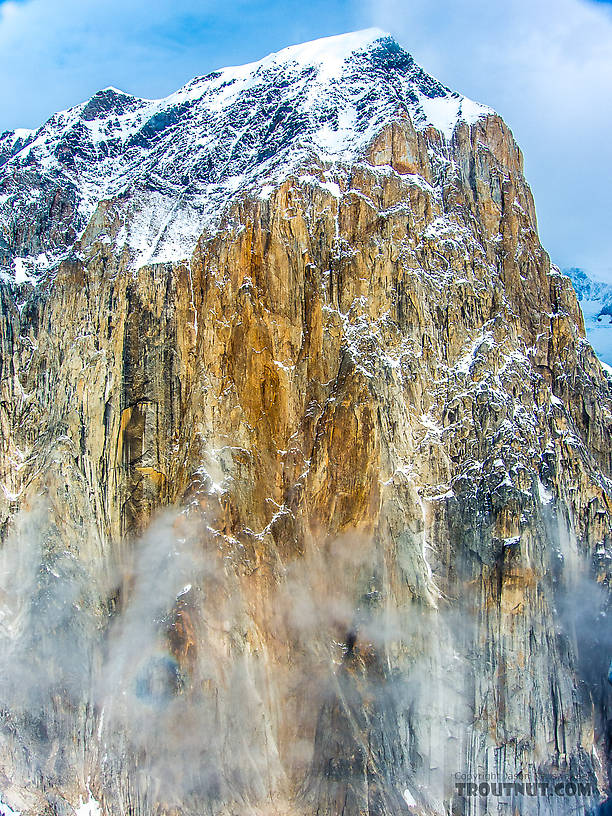
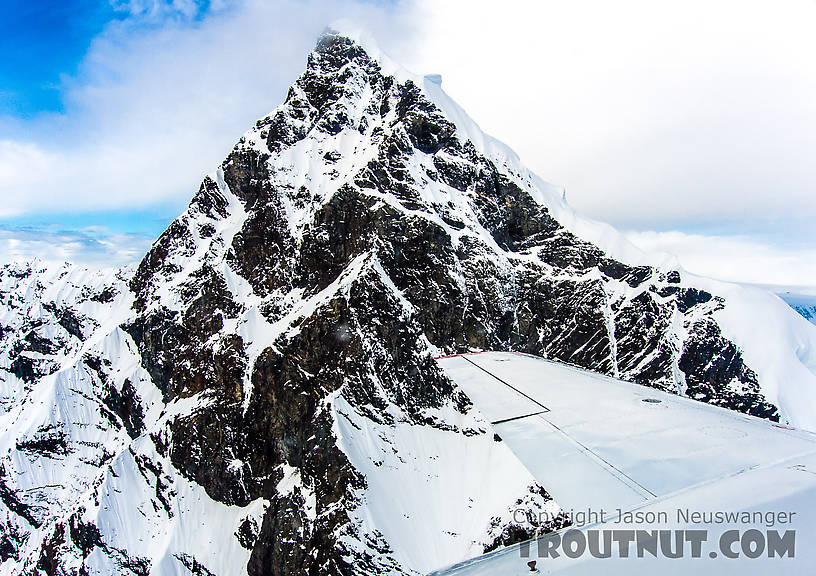
I was amazed at the effects of gravity on rock and ice. There were large piles of rubble atop the snow and ice at the base of many sheer rock faces. And there were huge, gaping crevasses arrayed in interesting patterns wherever a glacier flowed over uneven terrain. These highly variable breaks in snow/ice cover had not yet filled with new snow, so it was easy to see what dangerous obstacles they must present to those who would attempt to traverse them while climbing up and down the mountain. From our altitude, we could see the effects of friction along the side walls of the valleys through which these massive ice sheets flowed, giving the crevasses a crescent shape with convex centers leading the way downhill. They appeared even wider toward the middle wherever the ice spilled over a particularly steep ledge.
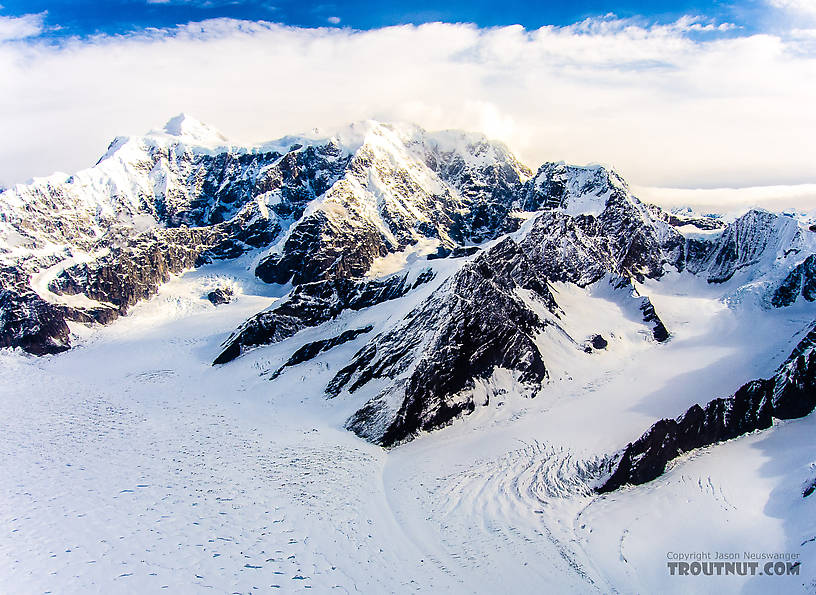
We observed the lateral (Lateral: To the side.) moraines formed at the edges of ice sheets and the dirty medial (Medial: Toward the middle of the body.) moraines formed by the joining of lateral (Lateral: To the side.) moraines of glaciers descending from adjacent valleys.
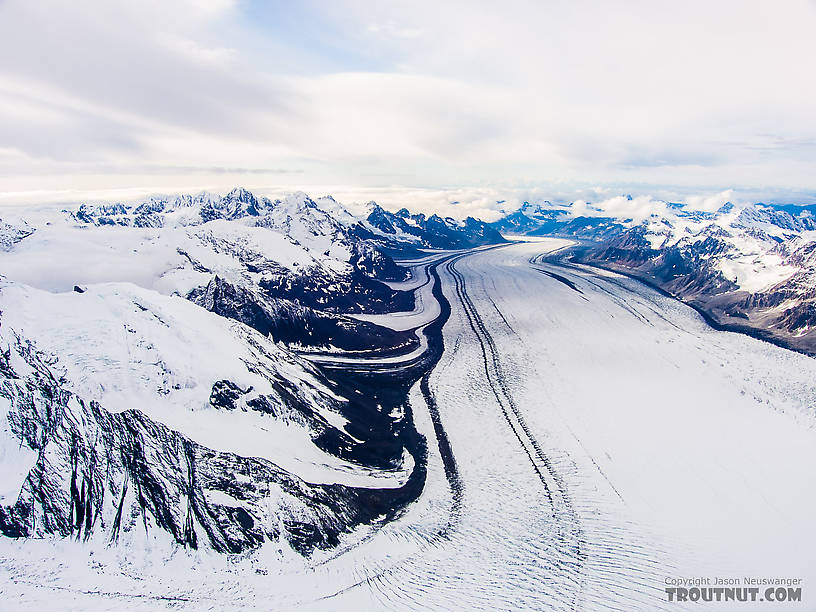
Ascending through various passes, we were treated to clear views of the summits of Mount Hunter and Mount Foraker. In a small plane surrounded by such grandeur, it was possible to understand what a camp-raiding raven might see while flying into this raw wilderness of rock and ice. Indeed, climbers sometimes return to food caches only to find that ravens have scattered them all over the ice and rock.
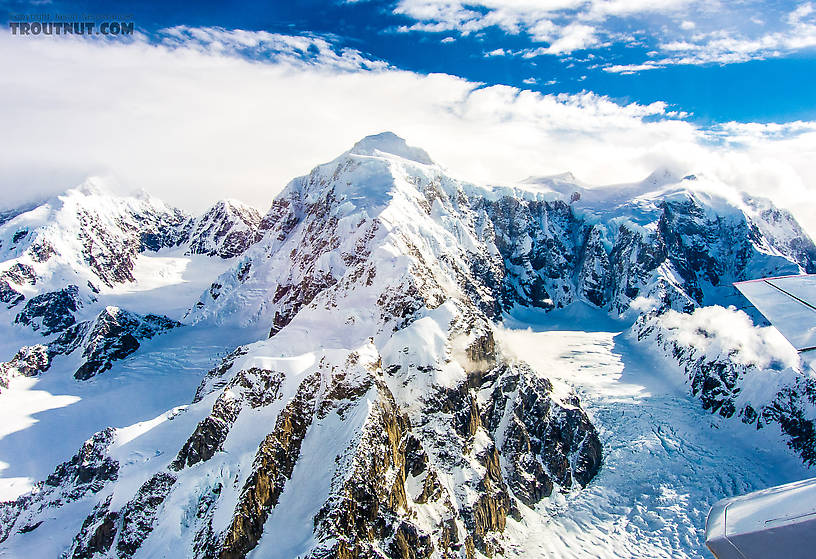
We saw the glaciated landing area where most Denali climbers are flown in, and we flew past a small amphitheater known by climbers as Camp 3. We also flew over the “Mountain House” – a cabin and outhouse flown in and built stick-by-stick on a small outcropping of rock in a glacier where planes can land. (Is this location the inspiration for “Mountain House” freeze-dried meals?)
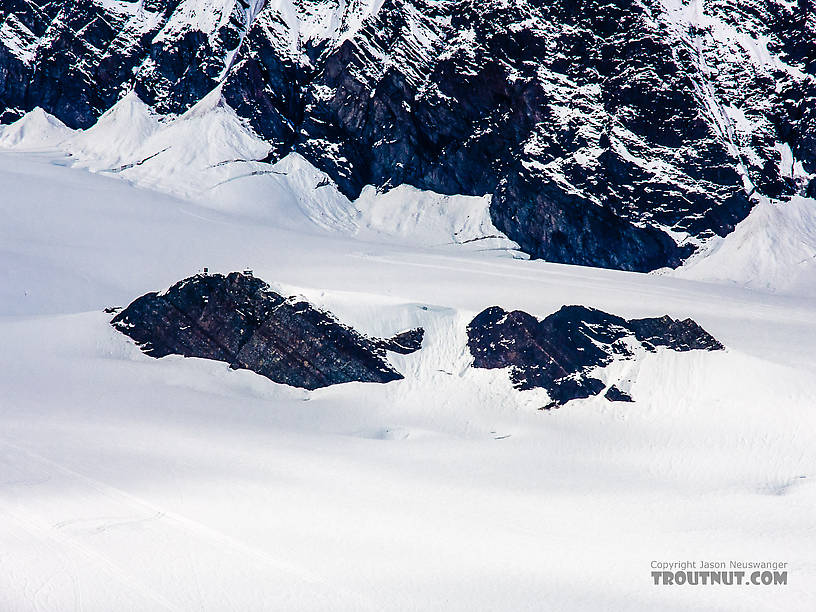
When I asked our pilot how they know the snow atop the glacier is firm enough to land, he said, “Well, normally the first flight of the day serves as the ‘guinea pig’ to determine that.” There have been several occasions when passengers had to exit the plane and pack down a “runway” with snowshoes so the plane could take off again. I’m glad we did not choose a flight that included a glacier landing. Occasionally we would fly over a glacial tarn – a small depression containing glacial melt-water reflecting a strikingly bright blue-green light. Our pilot called them “sapphires” because they resembled blue-green gems.
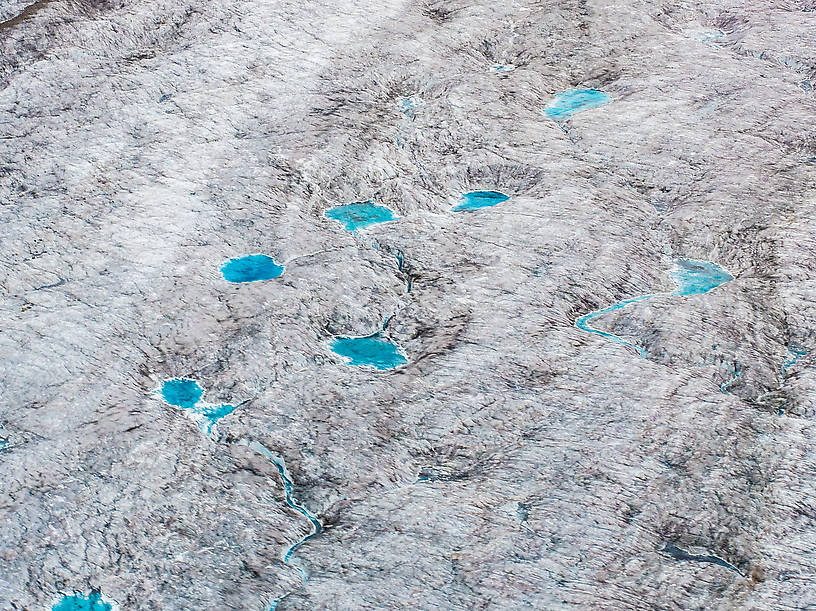
All in all, we got an eagle’s-eye view of a striking landscape that we would never have seen any other way. I came away with the impression that climbing these peaks would be a high-risk challenge that would not only be hard work, but would be miserably uncomfortable at times. The degree of suffering seems highly disproportional to the personal reward associated with achievement, especially the way groups are guided these days, where much of the hard, dangerous work is done by guides; and most reasonably fit people willing to suffer though the experience can reach the summit.
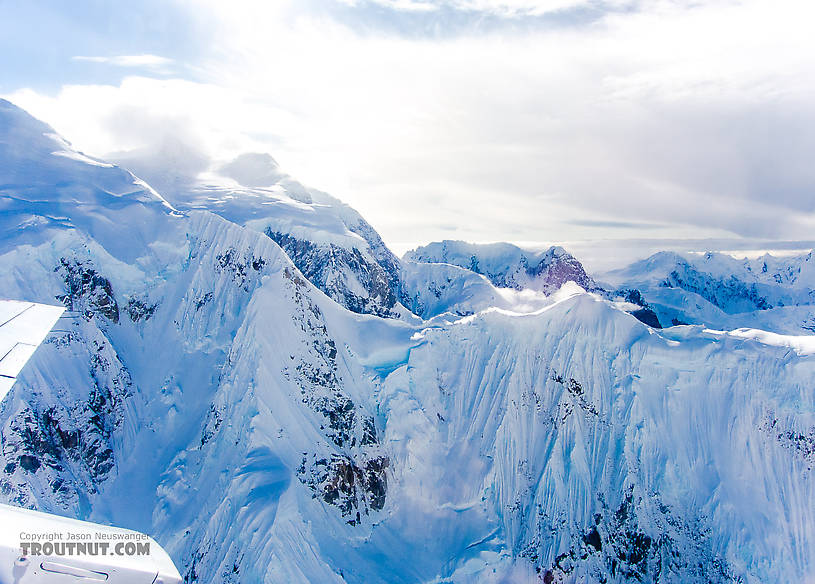
After the flight, we took a short drive through “downtown” Talkeetna, which was loaded with gift shops targeting cruise line visitors. We walked out on a well-trodden sandbar along the Susitna River, then bought some roasted almonds from an enterprising young girl before heading north to Fairbanks.
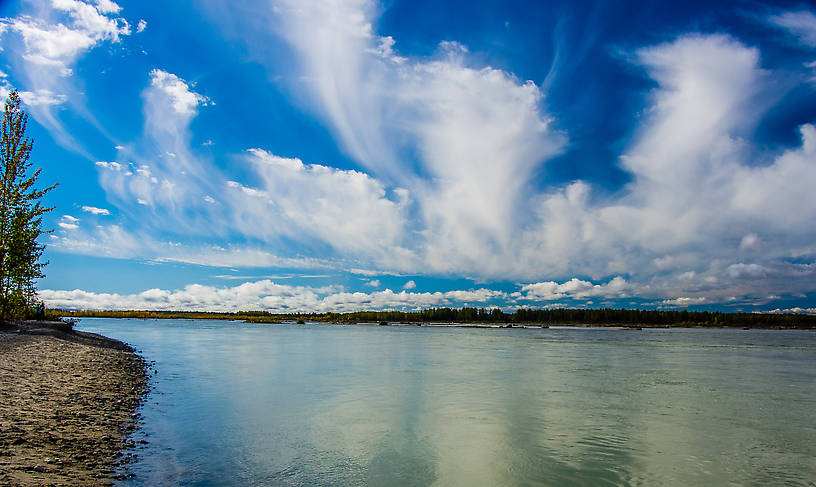
We drove at a leisurely pace while trying to catch a glimpse of the summit of Denali along the way. Twice we were fooled into thinking we may have seen it; but Jason confirmed later that we were seeing smaller snow-covered peaks in the foreground, including Mount Deception (where a group of senior tourists gushed over their good fortune in having finally “seen Denali”) and Mount Mather. Denali remained mysteriously cloaked in the high clouds.
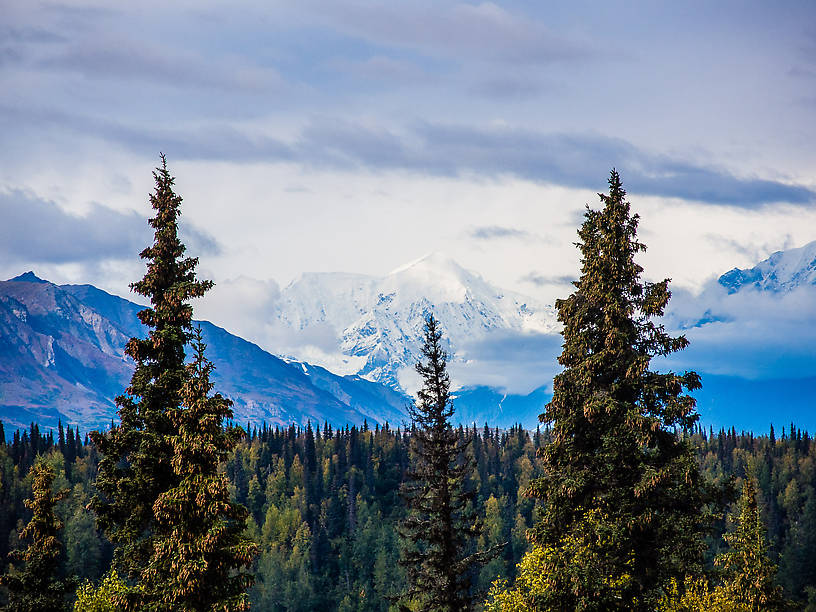
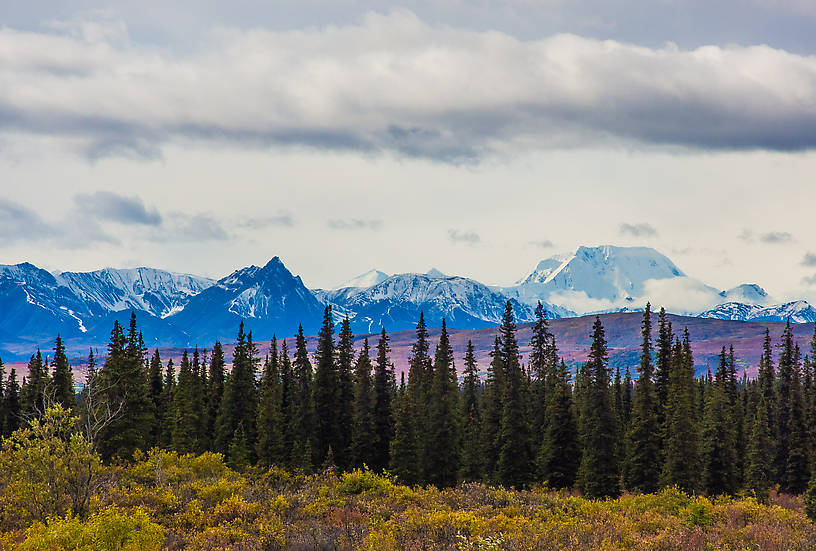
We stopped outside Denali National Park and had a late lunch at the Alaska Salmon Bake Restaurant, arriving back in Fairbanks by ~7 p.m. after a spectacular day of sight-seeing.

Our pilot and guide, Rick, was professional, knowledgeable, and had a good sense of humor, so he inspired confidence and provided entertaining narrative the entire 1.5-hour flight. Jason and I sat in the rear-most seats of the twin-engine, ten-seat plane, enjoying more legroom and greater lateral (Lateral: To the side.) vision than the other five passengers because we were far behind the wings.

Shortly after take-off, we flew over the highly braided channels of the converging Talkeetna, Chulitna, and Susitna rivers.

Within 15 minutes were entering the foothills of the Alaska Range. And before long we were viewing glaciers, sheer rock faces, and craggy peaks.



I was amazed at the effects of gravity on rock and ice. There were large piles of rubble atop the snow and ice at the base of many sheer rock faces. And there were huge, gaping crevasses arrayed in interesting patterns wherever a glacier flowed over uneven terrain. These highly variable breaks in snow/ice cover had not yet filled with new snow, so it was easy to see what dangerous obstacles they must present to those who would attempt to traverse them while climbing up and down the mountain. From our altitude, we could see the effects of friction along the side walls of the valleys through which these massive ice sheets flowed, giving the crevasses a crescent shape with convex centers leading the way downhill. They appeared even wider toward the middle wherever the ice spilled over a particularly steep ledge.

We observed the lateral (Lateral: To the side.) moraines formed at the edges of ice sheets and the dirty medial (Medial: Toward the middle of the body.) moraines formed by the joining of lateral (Lateral: To the side.) moraines of glaciers descending from adjacent valleys.

Ascending through various passes, we were treated to clear views of the summits of Mount Hunter and Mount Foraker. In a small plane surrounded by such grandeur, it was possible to understand what a camp-raiding raven might see while flying into this raw wilderness of rock and ice. Indeed, climbers sometimes return to food caches only to find that ravens have scattered them all over the ice and rock.

We saw the glaciated landing area where most Denali climbers are flown in, and we flew past a small amphitheater known by climbers as Camp 3. We also flew over the “Mountain House” – a cabin and outhouse flown in and built stick-by-stick on a small outcropping of rock in a glacier where planes can land. (Is this location the inspiration for “Mountain House” freeze-dried meals?)

When I asked our pilot how they know the snow atop the glacier is firm enough to land, he said, “Well, normally the first flight of the day serves as the ‘guinea pig’ to determine that.” There have been several occasions when passengers had to exit the plane and pack down a “runway” with snowshoes so the plane could take off again. I’m glad we did not choose a flight that included a glacier landing. Occasionally we would fly over a glacial tarn – a small depression containing glacial melt-water reflecting a strikingly bright blue-green light. Our pilot called them “sapphires” because they resembled blue-green gems.

All in all, we got an eagle’s-eye view of a striking landscape that we would never have seen any other way. I came away with the impression that climbing these peaks would be a high-risk challenge that would not only be hard work, but would be miserably uncomfortable at times. The degree of suffering seems highly disproportional to the personal reward associated with achievement, especially the way groups are guided these days, where much of the hard, dangerous work is done by guides; and most reasonably fit people willing to suffer though the experience can reach the summit.

After the flight, we took a short drive through “downtown” Talkeetna, which was loaded with gift shops targeting cruise line visitors. We walked out on a well-trodden sandbar along the Susitna River, then bought some roasted almonds from an enterprising young girl before heading north to Fairbanks.

We drove at a leisurely pace while trying to catch a glimpse of the summit of Denali along the way. Twice we were fooled into thinking we may have seen it; but Jason confirmed later that we were seeing smaller snow-covered peaks in the foreground, including Mount Deception (where a group of senior tourists gushed over their good fortune in having finally “seen Denali”) and Mount Mather. Denali remained mysteriously cloaked in the high clouds.


We stopped outside Denali National Park and had a late lunch at the Alaska Salmon Bake Restaurant, arriving back in Fairbanks by ~7 p.m. after a spectacular day of sight-seeing.
Photos by Troutnut from Denali National Park, Miscellaneous Alaska, and the Susitna River in Alaska
On The Road - Homer to Talkeetna
This was Day 4 of a five-day, father-son fishing trip to south-central Alaska. After a good night’s sleep at the Ocean Shores Motel in Homer, Jason and I packed up and went downtown to get a late breakfast. Homer Fish Processing did an excellent job vacuum sealing and freezing all our fish into 1-pound packages, so we put Jason’s fish into his cooler and arranged to have my fish shipped home. We stopped at a gift shop in Homer and toured the Oceans and Marine Visitor’s Center, which had some interesting displays and information about the Maritime Refuge system in Alaska.
By noon we had checked out of the motel and were headed back north, stopping only briefly to check out Quartz Creek (photo below) and enjoying the scenery along the Kenai River near Cooper Landing. We stopped at the new Cabela’s store in Anchorage, which had lots of impressive taxidermy and two big aquaria (one for unsociable rainbow trout only, and another with Dolly Varden, round whitefish, and Arctic grayling). Back on the road, we stopped for supper in Wasilla. We called ahead to the Swiss Alaska Inn in Talkeetna and had them leave the key in the door to our cabin in anticipation of our late arrival (~10:30 p.m.). The cabin was very clean and comfortable.
By noon we had checked out of the motel and were headed back north, stopping only briefly to check out Quartz Creek (photo below) and enjoying the scenery along the Kenai River near Cooper Landing. We stopped at the new Cabela’s store in Anchorage, which had lots of impressive taxidermy and two big aquaria (one for unsociable rainbow trout only, and another with Dolly Varden, round whitefish, and Arctic grayling). Back on the road, we stopped for supper in Wasilla. We called ahead to the Swiss Alaska Inn in Talkeetna and had them leave the key in the door to our cabin in anticipation of our late arrival (~10:30 p.m.). The cabin was very clean and comfortable.
Photos by Troutnut from Quartz Creek in Alaska
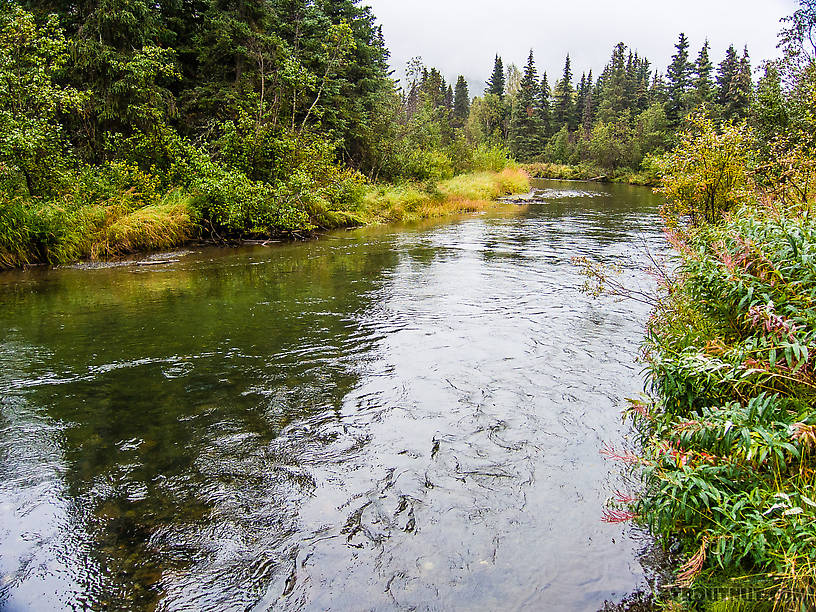
Quartz Creek near Cooper Landing
StateAlaska
LocationQuartz Creek
Date TakenSep 5, 2014
Date AddedDec 19, 2014
AuthorTroutnut
CameraNikon Coolpix P7700
Fishing Cook Inlet for Halibut and Kachemak Bay for King Salmon
This was Day 3 of a five-day, father-son fishing trip to south-central Alaska. Jason and I awakened and ate early, then drove down to “The Spit” in Homer where our charter was located. We arrived there at 7:30 a.m. and departed at 8:00 a.m. with the captain and his deckhand.
Seas were rough in the distant offshore area fished for lingcod and rockfish, so the itinerary had changed to fishing for Cook Inlet halibut in the morning and Kachemak Bay salmon in the afternoon. I was mildly concerned about the deckhand’s overly casual “safety speech” before we left port, especially when he said, “We have life jackets below deck… just don’t fall overboard.” (As it turns out, a later inspection revealed that life jackets were nowhere to be found after some rummaging around below deck.)
Our first offshore stop in a steady rain was on a mussel bed at a depth of 140’ where the captain thought there might be some bigger-than-average halibut. We caught only a couple small halibut (lots of bites/nibbles by various demersal creatures) and larger skates. The crew held skates (the “S-word” to them) in such disdain as to cut our hooks from their mouths and unceremoniously release them to suffer and die. I could not hook a halibut at this location. Finally the captain decided to move to a spot the charter boat skippers called “Old Faithful.”
It was mid-morning by the time we arrived, and the wind/waves were picking up. I was fine, but another client was miserably seasick and dealing with severe back pain. We started catching halibut here on herring-oil injected dead bait (herring), but the catch/bite ratio was low. We all missed many fish on the hookset, and had to rebait many times, which became an arduous task involving dragging a 3# weight up 140 feet every time a fish bit and stripped the bait (often within 10 seconds). But the action was fast and consistent enough that we eventually caught our limits of halibut (two each, one of which had to be under 29” long. I kept a 28” halibut and later caught the largest halibut of the trip, but didn’t measure its length.
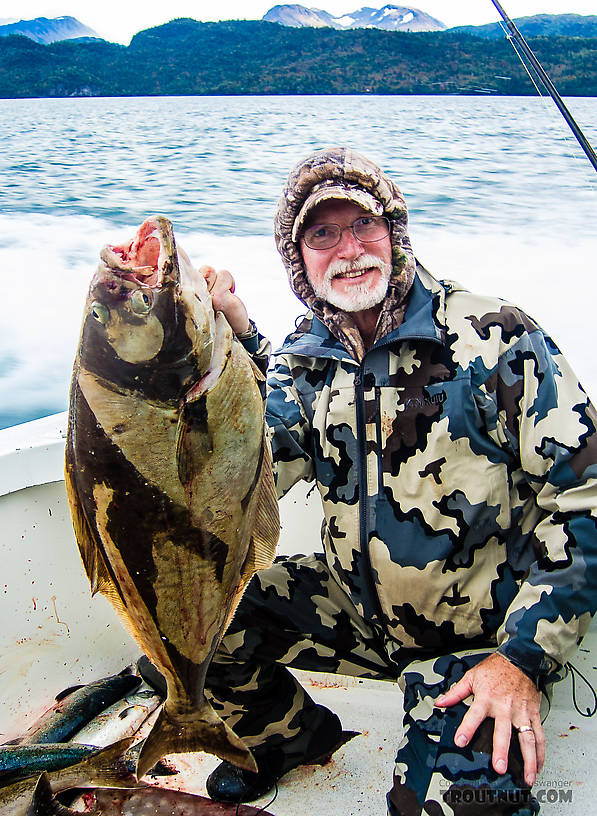
It was no trophy by any means, but it was one of the biggest fish I’ve ever caught. Jason finally got his second “keeper” halibut after releasing several small ones, allowing us to leave this open-water area as the weather deteriorated.
For the next hour we motored into the upper end of Kachemak Bay, which was relatively calm and protected from the wind. We were treated to a breathtaking view of glaciers at the head of the bay.

En route, the deckhand set us up to troll for king salmon (“feeder kings” that were not yet old enough to ascend a river to spawn). Depth was only ~40 feet, and sonar marked most fish at depths of 20-25 feet, so the downriggers were set accordingly. We trolled dead herring 5-6” long. The action here was pretty steady for a couple hours, resulting in many salmon missed, hooked, lost, and caught. I caught the first big salmon – a 33” fish that put up a great fight with numerous jumps and runs – quite exciting.
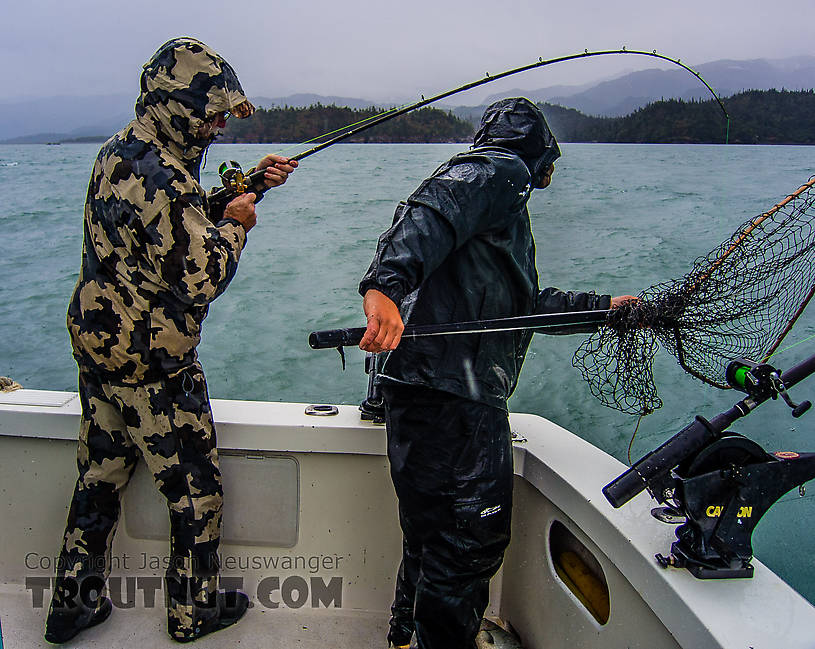

Eventually Jason and I both had two salmon that we were happy to keep (our limits).
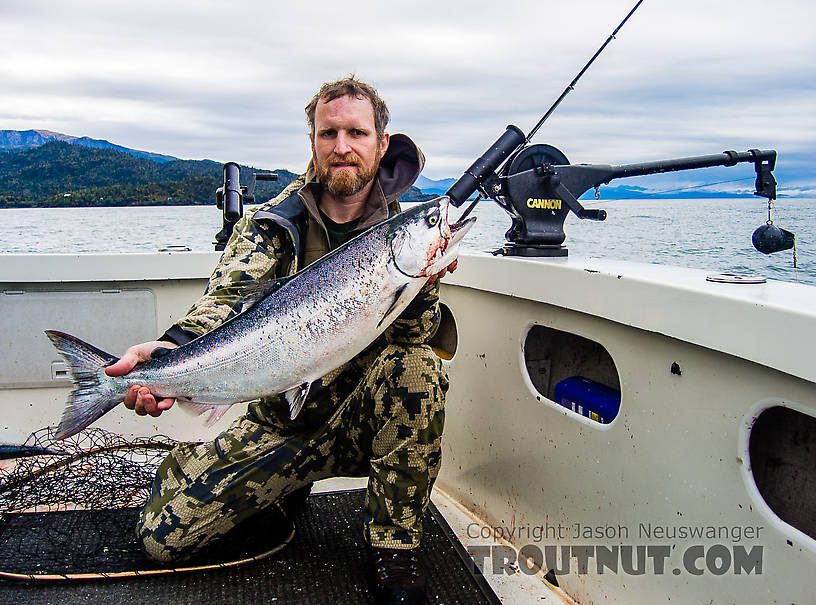
We stayed in the area for another hour while the captain tried to get his other clients their fish. By this time, the Packers were playing the Seahawks and holding their own (first half), but all I could do was follow the play-by-play on Jason’s iPhone. Finally the other clients caught their two fish, and we got back to port by 5:45 p.m. or so. The deckhand did a nice job filleting our fish on the way in (including one of Jason’s skates, which raised some eyebrows), and the Homer Fish Processing company met us at the dock to pick up our fish for vacuum packing and freezing.
We drove to the Sports Bar and Grill at the Beluga Lake Lodge as fast as possible and caught the last 1.5 quarters of the Packers-Seahawks game – about the time things went sour for the good guys. Still, we enjoyed a great meal and represented Green Bay by wearing the green and gold. Back at the Ocean Shores Motel, I took a long, hot bath in order to thaw out some joints that had gotten very stiff during a long day of exposure to cold rain and wind.
Seas were rough in the distant offshore area fished for lingcod and rockfish, so the itinerary had changed to fishing for Cook Inlet halibut in the morning and Kachemak Bay salmon in the afternoon. I was mildly concerned about the deckhand’s overly casual “safety speech” before we left port, especially when he said, “We have life jackets below deck… just don’t fall overboard.” (As it turns out, a later inspection revealed that life jackets were nowhere to be found after some rummaging around below deck.)
Our first offshore stop in a steady rain was on a mussel bed at a depth of 140’ where the captain thought there might be some bigger-than-average halibut. We caught only a couple small halibut (lots of bites/nibbles by various demersal creatures) and larger skates. The crew held skates (the “S-word” to them) in such disdain as to cut our hooks from their mouths and unceremoniously release them to suffer and die. I could not hook a halibut at this location. Finally the captain decided to move to a spot the charter boat skippers called “Old Faithful.”
It was mid-morning by the time we arrived, and the wind/waves were picking up. I was fine, but another client was miserably seasick and dealing with severe back pain. We started catching halibut here on herring-oil injected dead bait (herring), but the catch/bite ratio was low. We all missed many fish on the hookset, and had to rebait many times, which became an arduous task involving dragging a 3# weight up 140 feet every time a fish bit and stripped the bait (often within 10 seconds). But the action was fast and consistent enough that we eventually caught our limits of halibut (two each, one of which had to be under 29” long. I kept a 28” halibut and later caught the largest halibut of the trip, but didn’t measure its length.

It was no trophy by any means, but it was one of the biggest fish I’ve ever caught. Jason finally got his second “keeper” halibut after releasing several small ones, allowing us to leave this open-water area as the weather deteriorated.
For the next hour we motored into the upper end of Kachemak Bay, which was relatively calm and protected from the wind. We were treated to a breathtaking view of glaciers at the head of the bay.

En route, the deckhand set us up to troll for king salmon (“feeder kings” that were not yet old enough to ascend a river to spawn). Depth was only ~40 feet, and sonar marked most fish at depths of 20-25 feet, so the downriggers were set accordingly. We trolled dead herring 5-6” long. The action here was pretty steady for a couple hours, resulting in many salmon missed, hooked, lost, and caught. I caught the first big salmon – a 33” fish that put up a great fight with numerous jumps and runs – quite exciting.


Eventually Jason and I both had two salmon that we were happy to keep (our limits).

We stayed in the area for another hour while the captain tried to get his other clients their fish. By this time, the Packers were playing the Seahawks and holding their own (first half), but all I could do was follow the play-by-play on Jason’s iPhone. Finally the other clients caught their two fish, and we got back to port by 5:45 p.m. or so. The deckhand did a nice job filleting our fish on the way in (including one of Jason’s skates, which raised some eyebrows), and the Homer Fish Processing company met us at the dock to pick up our fish for vacuum packing and freezing.
We drove to the Sports Bar and Grill at the Beluga Lake Lodge as fast as possible and caught the last 1.5 quarters of the Packers-Seahawks game – about the time things went sour for the good guys. Still, we enjoyed a great meal and represented Green Bay by wearing the green and gold. Back at the Ocean Shores Motel, I took a long, hot bath in order to thaw out some joints that had gotten very stiff during a long day of exposure to cold rain and wind.
Photos by Troutnut from Kachemak Bay in Alaska
Fishing the Kenai River
This was Day 2 of a five-day, father-son fishing trip to south-central Alaska. The alarm clock awakened Jason and I early (5:15 a.m.) so we would have time to eat breakfast, pack, and meet our guide at the Troutfitter’s fly shop by 6:00 a.m. Wish we’d had more time to enjoy the deluxe accommodations. Our guide for the day was a good-natured young man (late 20s) from Montana named Jeff Heiskell, who was in his third season of guiding for trophy rainbows and Dolly Varden on the Kenai River. We were to be joined on this trip by a Major in the U.S. Air Force who is an avid fly fisherman and was looking forward to escaping his increasingly administrative job to enjoy three days of not making decisions. I understood completely.
Our destination was 45 minutes west of Cooper Landing along the Sterling Highway on the way to Homer (our next stop), so we paid our lodging and guide charges, packed everything up, and drove in tandem with our guide to the take-out point at Bing’s Landing, several river miles downstream of the put-in point near the lower end of Skilak Lake. We left our vehicle there and rode upstream to the put-in with Jeff, who was towing a 19-foot drift boat (to be shuttled to the take-out during the day by a third-party shuttle service).
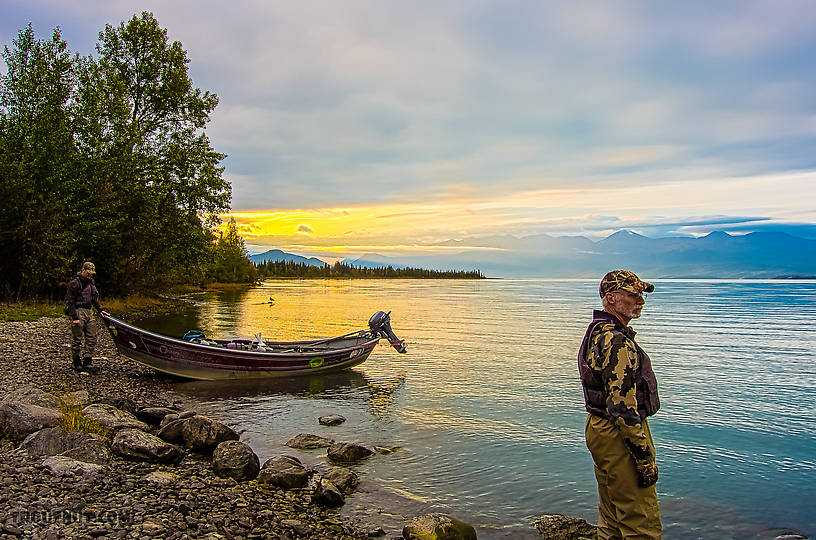
Some anglers fish Skilak for lake trout, but most simply use the lake as a point of access to the Kenai River flowing out of it. As soon as we reached flowing water, it was obvious the “pinks” had arrived in great number – this being the alternate year in which most pink salmon would make their spawning run in this system. (The water was a beautiful but cloudy shade of turquoise blue, so we could not see the salmon underwater; but they would frequently breach the surface.)

Rainbow trout and Dolly Varden char would be gorging themselves on eggs below shallow riffles covered with spawning pink salmon. This can work for or against anglers, depending on the number of live eggs available to feeding trout. A moderate number of eggs attracts concentrations of trout to these areas where anglers can target them. But a high number of eggs can result in a “glut” as the guides call it – a situation in which an angler’s bead may be akin to the proverbial “needle in a haystack” amid the millions of real salmon eggs drifting in the current. We eventually learned that we had, indeed, arrived during a glut.
Jeff provided instruction (which I appreciated but Jason and the Major did not need) on the proper technique for roll-casting his 6-weight fly rods and mending the lines in order to maximize the time our weighted beads (attached ~2” up from #6 barbless hooks) would drift naturally in the current alongside the skillfully rowed drift boat. We began fishing on a riffle within sight of the lower end of Skilak Lake, where anglers in other boats were casting spoons for silver salmon with some success.
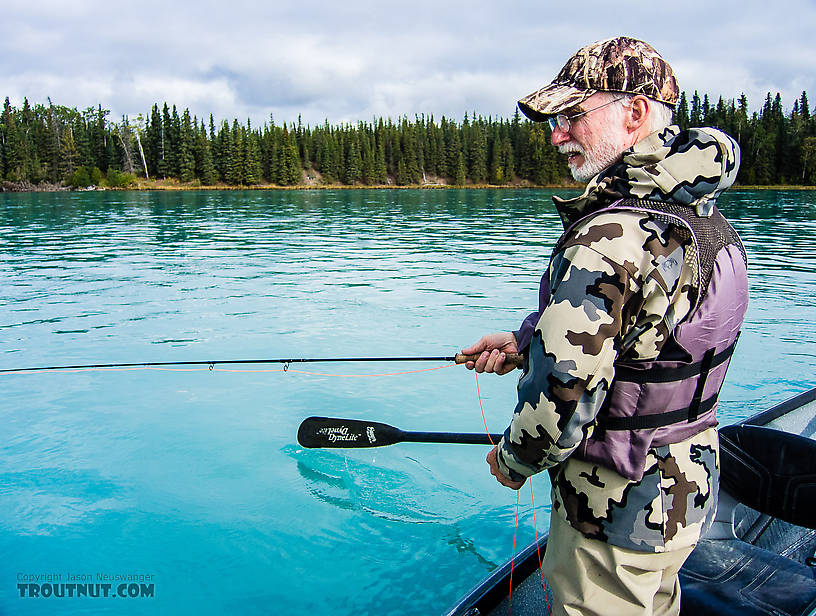
We began catching pink salmon almost immediately – some in the mouth and some snagged accidentally in mid-body that fought particularly hard. I thought they were interesting to see and fun to catch, but Jeff viewed the “humpies” (spawning males) we caught with much disdain; he unhooked them with annoyed alacrity at boatside as quickly as possible before resuming the search for our principle quarry (trophy rainbows and Dolly Varden).
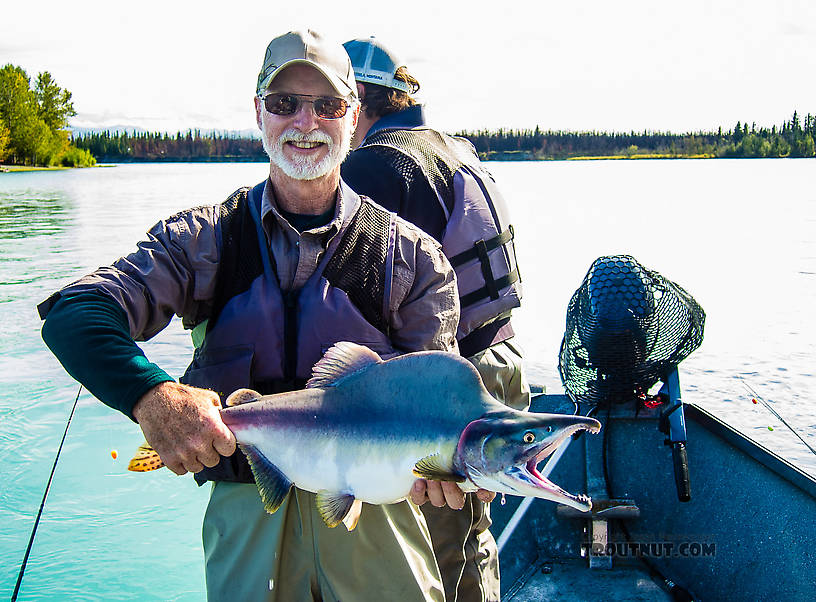
I hooked the first sizeable rainbow trout (mid-20s), which made a strong run and leaped far enough out of the water for a positive ID before it spit the barbless hook. We made several passes over this first riffle – drift fishing downstream and motoring back upstream – because we were having slow but steady action with “small” rainbow trout (14-18”). Jason was substantially out-fishing me and the Major, presumably due to his extraordinary ability to detect and react to real bites. Action slowed and we moved downstream to the next major spawning riffle. Again, we caught mostly pink salmon, which I was personally thrilled to see and catch, even if seasoned Alaskan trout anglers regard them as something akin to motile algae.
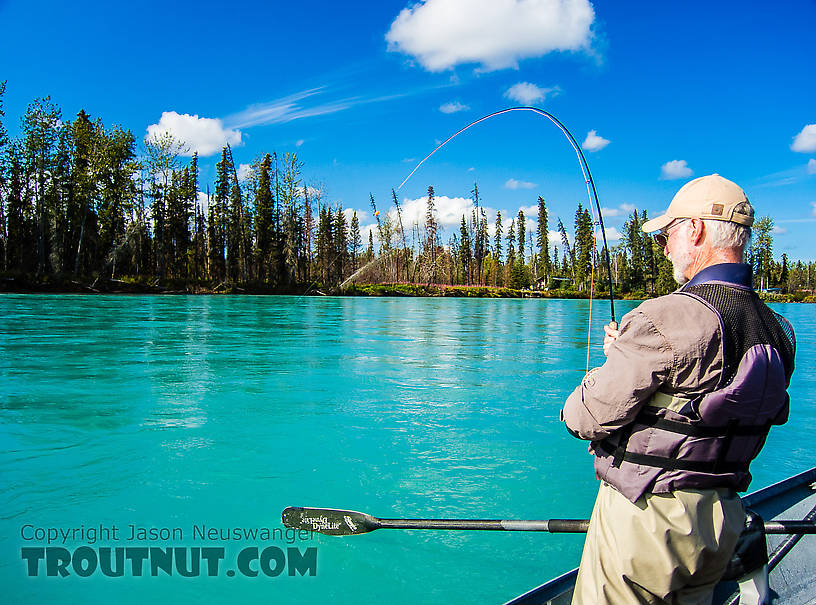
The sun appeared and the air warmed around mid-day, so we stopped to shed outer layers and eat lunch amid some small islands on the inside of a large bend where the pink salmon were spawning. Brief excursions to shore revealed many salmon redds in the shallow channels between the islands, and many salmon carcasses that had been dragged onshore by bears or other animals. We saw no bears on this trip.
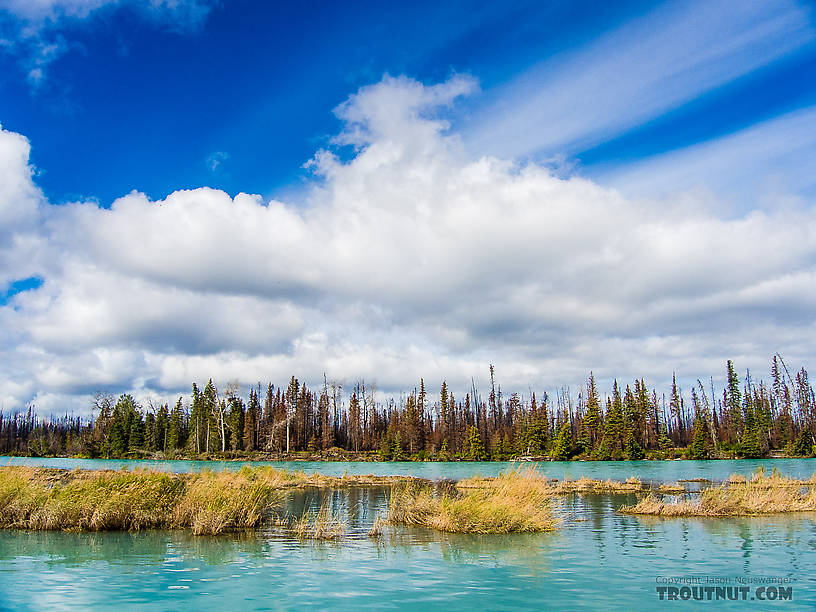
The riparian corridor was wild and undeveloped in the upper reach of this float, but as we progressed downstream, private cabins appeared all along the shoreline. In one of the more highly developed areas, we fished another spawning riffle loaded with pink salmon and caught several more trout, including Dolly Varden; and Jason caught and released his largest rainbow (photographed with guide). Our take-out at Bing’s Landing was only another mile or so downstream.
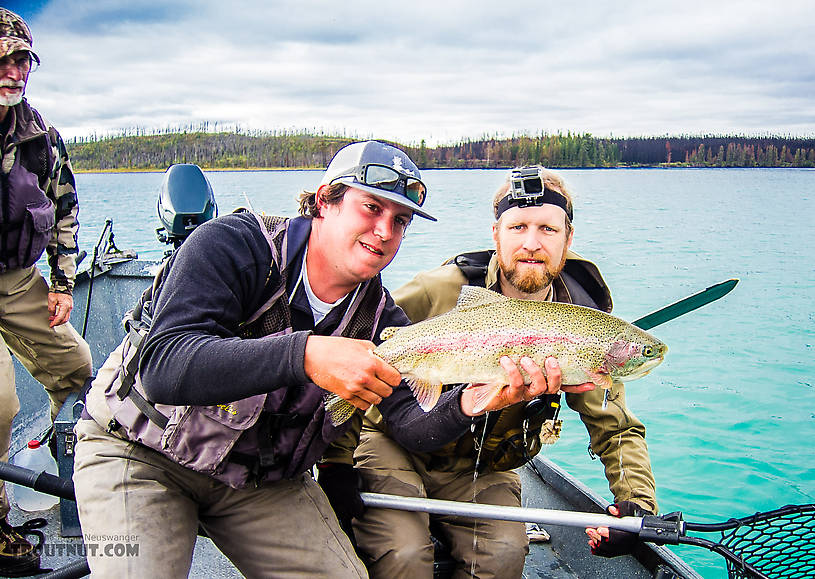
We ended our float shortly after 5:00 p.m., bid farewell to Jeff and the Major, who had been a superb fishing companion, then headed west and south for Homer. The west side of the Kenai Peninsula offered great scenery, including a view over Ninilchik of volcanic Mount Iliamna.
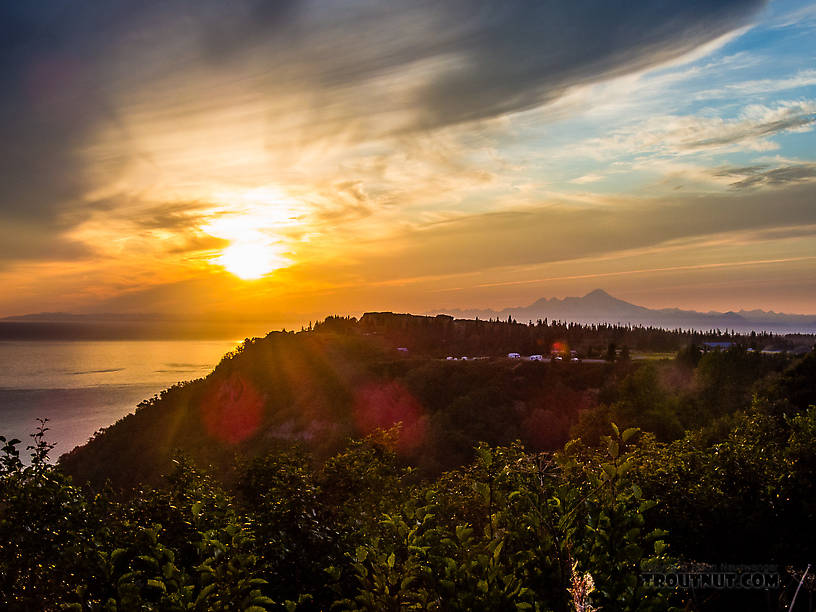
We arrived in Homer just before sunset. After encountering numerous road construction delays on “The Spit” (to locate our charter service office), we doubled back to the Ocean Shores Motel by ~10:30 p.m. for a good night’s sleep before tomorrow’s charter fishing trip.
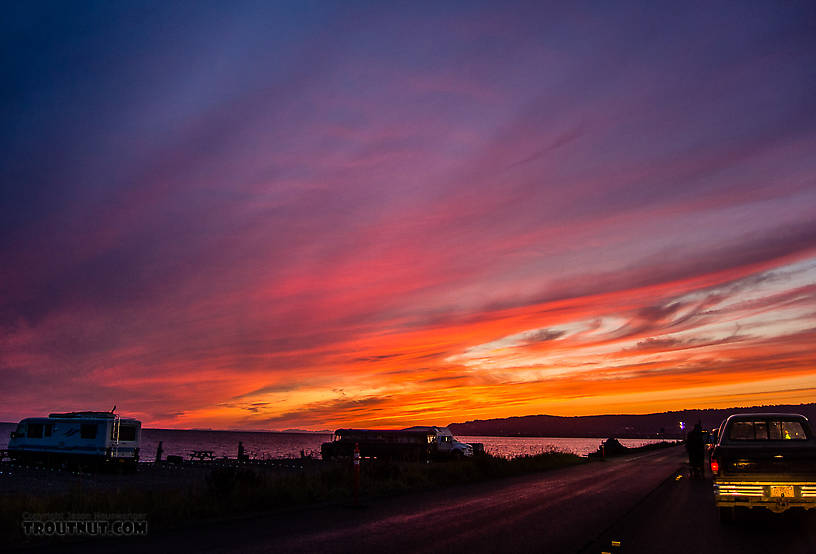
Our destination was 45 minutes west of Cooper Landing along the Sterling Highway on the way to Homer (our next stop), so we paid our lodging and guide charges, packed everything up, and drove in tandem with our guide to the take-out point at Bing’s Landing, several river miles downstream of the put-in point near the lower end of Skilak Lake. We left our vehicle there and rode upstream to the put-in with Jeff, who was towing a 19-foot drift boat (to be shuttled to the take-out during the day by a third-party shuttle service).

Some anglers fish Skilak for lake trout, but most simply use the lake as a point of access to the Kenai River flowing out of it. As soon as we reached flowing water, it was obvious the “pinks” had arrived in great number – this being the alternate year in which most pink salmon would make their spawning run in this system. (The water was a beautiful but cloudy shade of turquoise blue, so we could not see the salmon underwater; but they would frequently breach the surface.)

Rainbow trout and Dolly Varden char would be gorging themselves on eggs below shallow riffles covered with spawning pink salmon. This can work for or against anglers, depending on the number of live eggs available to feeding trout. A moderate number of eggs attracts concentrations of trout to these areas where anglers can target them. But a high number of eggs can result in a “glut” as the guides call it – a situation in which an angler’s bead may be akin to the proverbial “needle in a haystack” amid the millions of real salmon eggs drifting in the current. We eventually learned that we had, indeed, arrived during a glut.
Jeff provided instruction (which I appreciated but Jason and the Major did not need) on the proper technique for roll-casting his 6-weight fly rods and mending the lines in order to maximize the time our weighted beads (attached ~2” up from #6 barbless hooks) would drift naturally in the current alongside the skillfully rowed drift boat. We began fishing on a riffle within sight of the lower end of Skilak Lake, where anglers in other boats were casting spoons for silver salmon with some success.

We began catching pink salmon almost immediately – some in the mouth and some snagged accidentally in mid-body that fought particularly hard. I thought they were interesting to see and fun to catch, but Jeff viewed the “humpies” (spawning males) we caught with much disdain; he unhooked them with annoyed alacrity at boatside as quickly as possible before resuming the search for our principle quarry (trophy rainbows and Dolly Varden).

I hooked the first sizeable rainbow trout (mid-20s), which made a strong run and leaped far enough out of the water for a positive ID before it spit the barbless hook. We made several passes over this first riffle – drift fishing downstream and motoring back upstream – because we were having slow but steady action with “small” rainbow trout (14-18”). Jason was substantially out-fishing me and the Major, presumably due to his extraordinary ability to detect and react to real bites. Action slowed and we moved downstream to the next major spawning riffle. Again, we caught mostly pink salmon, which I was personally thrilled to see and catch, even if seasoned Alaskan trout anglers regard them as something akin to motile algae.

The sun appeared and the air warmed around mid-day, so we stopped to shed outer layers and eat lunch amid some small islands on the inside of a large bend where the pink salmon were spawning. Brief excursions to shore revealed many salmon redds in the shallow channels between the islands, and many salmon carcasses that had been dragged onshore by bears or other animals. We saw no bears on this trip.

The riparian corridor was wild and undeveloped in the upper reach of this float, but as we progressed downstream, private cabins appeared all along the shoreline. In one of the more highly developed areas, we fished another spawning riffle loaded with pink salmon and caught several more trout, including Dolly Varden; and Jason caught and released his largest rainbow (photographed with guide). Our take-out at Bing’s Landing was only another mile or so downstream.

We ended our float shortly after 5:00 p.m., bid farewell to Jeff and the Major, who had been a superb fishing companion, then headed west and south for Homer. The west side of the Kenai Peninsula offered great scenery, including a view over Ninilchik of volcanic Mount Iliamna.

We arrived in Homer just before sunset. After encountering numerous road construction delays on “The Spit” (to locate our charter service office), we doubled back to the Ocean Shores Motel by ~10:30 p.m. for a good night’s sleep before tomorrow’s charter fishing trip.

Photos by Troutnut from Cook Inlet and the Kenai River in Alaska
Road Trip to the Kenai Peninsula
This was the first day of a five-day, father-son fishing trip to south-central Alaska. Jason and I had to scramble to assemble all gear and personal items needed for the next series of adventures, but by noon we had returned my rented packraft, deposited Taiga with the dog-sitter, and were on our way south on the Parks Highway to the Kenai Peninsula. We made a quick stop near Mystery Creek #170 to see how stream flow had responded to recent heavy rains. What had been a tranquil, crystal clear stream a week earlier was now a raging torrent of reddish-brown water. We could not have worked there under these conditions.
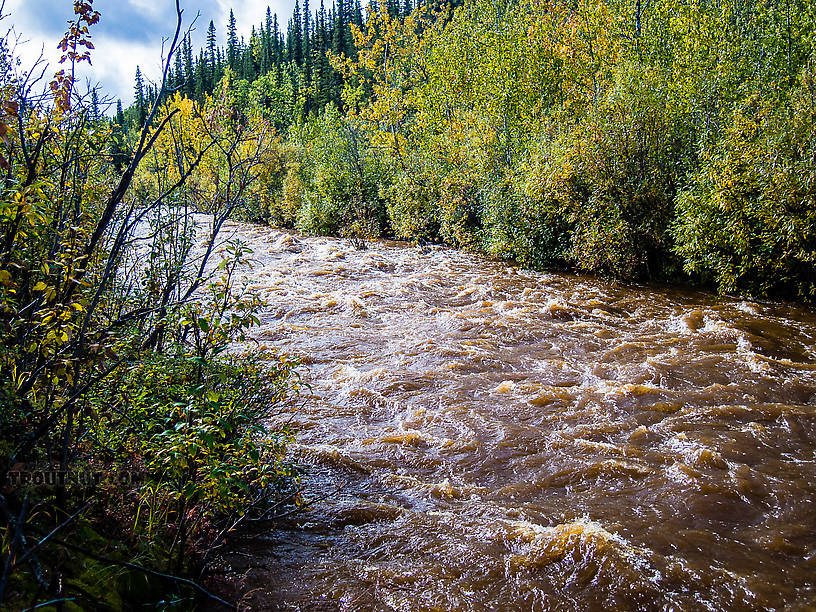
Time passed quickly as we enjoyed beautiful scenery along the Parks Highway and listened to a great 1997 book on tape entitled “Into Thin Air” by climber/author Jon Krakauer – chronicling the Mount Everest disaster a few years earlier. The hardships, dangers, and tragedies experienced by people involved in that ill-fated expedition struck close to home while moving through the shadow of Denali, especially after trekking through the Clearwater Mountains for the past few days and experiencing less intense but nonetheless heart-pounding wilderness dangers firsthand.
On this, my first venture south of Cantwell on the Parks Highway, I became aware of the increasing height and diversity of tree species as we approached the Pacific Ocean – the source of moisture and moderate temperature needed to sustain greater biodiversity. Upon entering the Mat-Su Valley (where the Matanuska and Susitna river valleys converge on Cook Inlet), I was surprised to spend at least 10 minutes driving through the modern, prosperous, and sprawling municipality of Wasilla, Alaska, which most of us had been led to believe was the quaint little rural hometown of a former mayor and governor turned vice-presidential candidate. Numerous big box stores and corporate headquarter offices revealed the true nature of Wasilla. Anchorage was a bit of a surprise too, mainly because there was no striking evidence to the casual observer of the effects of any past seismic events on buildings, roads, or bridges. It was just another modern American port city surrounded by the beautiful snow-capped peaks of the Chugach Mountains.
Because we were burning daylight, we passed quickly through Anchorage and ate on the road as we proceeded down the Seward Highway around the Turnagain Arm of Cook Inlet, which was at low tide. Some adventurous young people were kite surfing off rocky cliffs against the backdrop of a splendid ocean sunset.
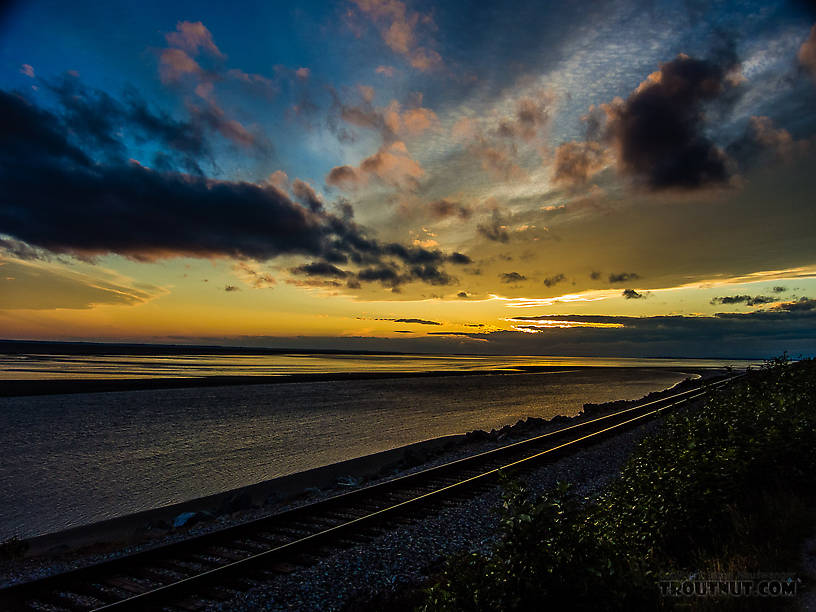
Darkness descended as we approached Cooper’s Landing along the Kenai River, but I could see that it was a beautiful area, with a dense forest of tall trees and numerous luxury lodges catering to wealthy fly fishermen who travel here to pursue trophy trout and salmon in the Kenai and Russian rivers. We reached the Troutfitter’s Lodge at 11:00 p.m. and eventually found our “Swan Sanctuary” cabin downhill from the fly shop – a luxurious housekeeping “cottage” built with large logs and fully appointed with woodsy furniture and décor. We prepared for a quick departure in the morning and hit the sack by midnight.

Time passed quickly as we enjoyed beautiful scenery along the Parks Highway and listened to a great 1997 book on tape entitled “Into Thin Air” by climber/author Jon Krakauer – chronicling the Mount Everest disaster a few years earlier. The hardships, dangers, and tragedies experienced by people involved in that ill-fated expedition struck close to home while moving through the shadow of Denali, especially after trekking through the Clearwater Mountains for the past few days and experiencing less intense but nonetheless heart-pounding wilderness dangers firsthand.
On this, my first venture south of Cantwell on the Parks Highway, I became aware of the increasing height and diversity of tree species as we approached the Pacific Ocean – the source of moisture and moderate temperature needed to sustain greater biodiversity. Upon entering the Mat-Su Valley (where the Matanuska and Susitna river valleys converge on Cook Inlet), I was surprised to spend at least 10 minutes driving through the modern, prosperous, and sprawling municipality of Wasilla, Alaska, which most of us had been led to believe was the quaint little rural hometown of a former mayor and governor turned vice-presidential candidate. Numerous big box stores and corporate headquarter offices revealed the true nature of Wasilla. Anchorage was a bit of a surprise too, mainly because there was no striking evidence to the casual observer of the effects of any past seismic events on buildings, roads, or bridges. It was just another modern American port city surrounded by the beautiful snow-capped peaks of the Chugach Mountains.
Because we were burning daylight, we passed quickly through Anchorage and ate on the road as we proceeded down the Seward Highway around the Turnagain Arm of Cook Inlet, which was at low tide. Some adventurous young people were kite surfing off rocky cliffs against the backdrop of a splendid ocean sunset.

Darkness descended as we approached Cooper’s Landing along the Kenai River, but I could see that it was a beautiful area, with a dense forest of tall trees and numerous luxury lodges catering to wealthy fly fishermen who travel here to pursue trophy trout and salmon in the Kenai and Russian rivers. We reached the Troutfitter’s Lodge at 11:00 p.m. and eventually found our “Swan Sanctuary” cabin downhill from the fly shop – a luxurious housekeeping “cottage” built with large logs and fully appointed with woodsy furniture and décor. We prepared for a quick departure in the morning and hit the sack by midnight.
Photos by Troutnut from Mystery Creek #170 and Cook Inlet in Alaska
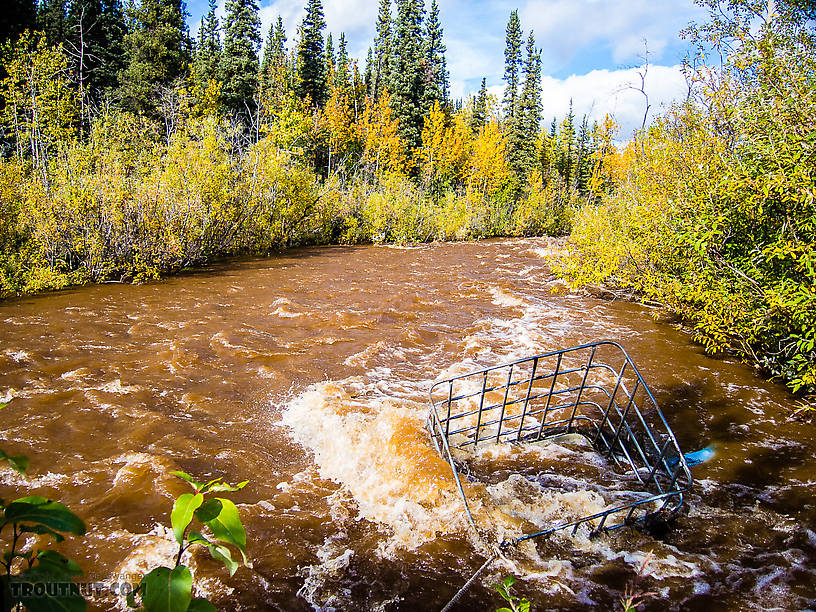


Railroad along the Turnagain Arm of Cook Inlet
StateAlaska
LocationTurnagain Arm of Cook Inlet
Date TakenSep 2, 2014
Date AddedDec 19, 2014
AuthorTroutnut
CameraNikon Coolpix P7700
Top 10 Fly Hatches
Top Gift Shop Designs
Eat mayflies.
Top Insect Specimens
Miscellaneous Sites
Troutnut.com is copyright © 2004-2024 Jason
Neuswanger (email Jason). See my FAQ for information about use of my images.
 privacy policy
privacy policy



